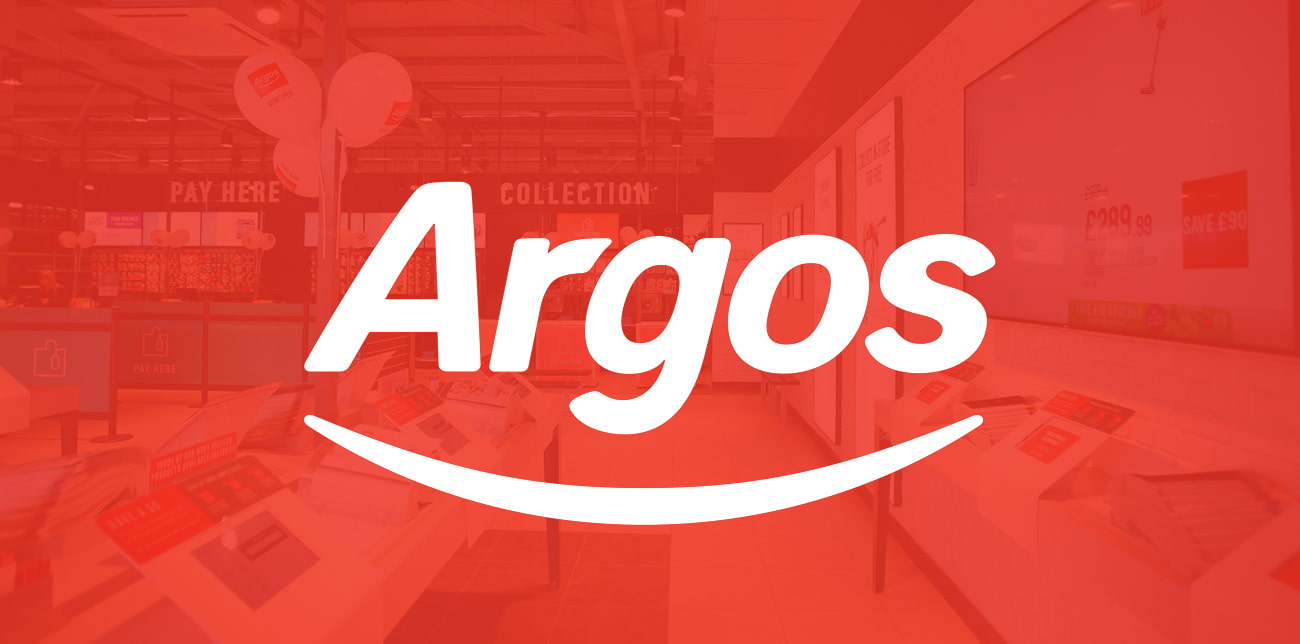Founded in 1972, Argos is a UK catalog retailer serving the United Kingdom and Ireland through multiple shopping channels. In its 50-year history, the store has undergone many changes and now serves as a popular shopping destination with over 130 million customers annually. Argos is the fourth most popular online retailer in the UK, generating over $5.2 million US dollars in sales as of 2021. This case study explores how Argos’ marketing strategy adapted from its humble origins as a catalog retailer to a retail giant using an omnichannel strategy.
Don’t have the time to listen? Listen on the go!
A journey through the history of the renowned UK catalog retailer
As this Argos’ case study shows, the company started small and has since used different strategies, including omnichannel marketing, to grow. Through the years, Argos has been recognized with multiple marketing awards, including the 2015 Multi-Channel Retailer of the Year award from Retail Week. The store is the first in the UK to hit the £1 billion mark in sales.
Early days
Argos was founded in 1972 by Richard Tompkins, a British entrepreneur who started Green Shield Stamps. These were promotional stamps customers used to buy merchandise from participating retailers. Argos was initially called the Green Shield Gift House, a catalog where people could spend their stamps.
In 1973, he rebranded the catalog, calling it Argos, later opening a storefront in the same year. In its first year, the company made over £1 million in sales.
Expansion and development

UK tobacco company BAT Industries purchased Argos in 1979 and operated the brand until 1990. During this time, Argos opened a jewelry counter that eventually grew and became one of the largest jewelry retailers in the UK. The company changed hands a few more times from 1990 to 2016 while staying true to its branding.
Argos’ branding strategies build around choice, value, and convenience — the exact features it has offered its customers since its catalog beginnings. It provided internet-style shopping before the internet, offering a wide array of products customers could buy and have delivered directly to their homes.
This retail chain has withstood multiple recessions and later decided to modernize its products following the 2008 financial crash. Five years after the economic downturn, Argos had to close 75 physical stores, while testing new in-store tech at its Camden location. Guests could look through the catalog on iPads within the store and order while shopping for other merch. Soon, this fast and convenient approach to shopping and delivery drove growth. Argos’ marketing strategy helped the company sustain its growth and garnered praise from retail industry insiders, who appreciated its omnichannel approach.
2016: Argos’ acquisition by Sainsbury
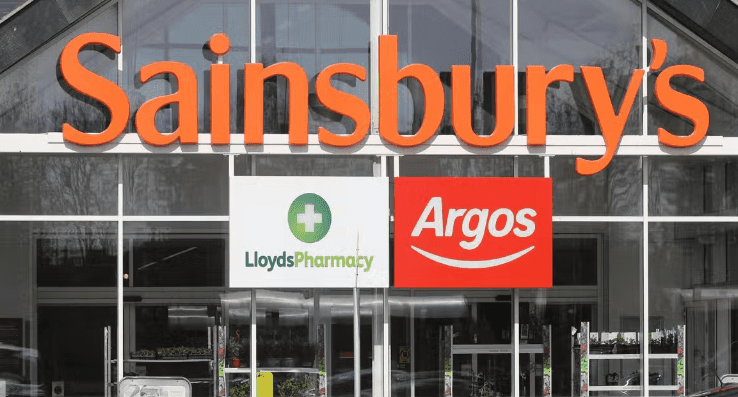
In 2016, Argos was acquired by the British supermarket brand Sainsbury for £1.3 billion. The acquisition broadened Argos’ customer base and gave Sainsbury access to a larger delivery network. Since 2016, Argos has continued to modify its website and mobile apps for better brand consistency and a seamless shopping experience, regardless of which channel a customer is using.
Analyzing Argos’ marketing strategy
Argos has accomplished a huge feat through its marketing strategy, remaining competitive against eCommerce giants like Amazon. Argos’ market share has remained consistent in UK eCommerce, and grew in its early days, by expanding its product offerings and opening retail locations to supplement catalog sales.
Argos’ online marketing strategy includes targeting customers with specific offers based on their geographic location and customizing a simple website that is sleek and user-friendly. As you move on with this overview, you can learn more about how specific elements of the Argos’ marketing strategy have contributed to its success.
Argos target markets
Since Argos is a general retailer where customers can buy a wide range of products, its target market is households. While the company stopped printing its catalog in 2020, it distributed it to millions of households in the United Kingdom and Ireland. Plus, Sainsbury frequently conducts Argos customer satisfaction surveys to ensure they always target the correct customers with the right products. The company offers competitive prices, which allows it to target price-conscious customers. Plus, it started its Homebase brand, offering home goods to more affluent customers.
Argos pricing strategies

The company keeps an eye on the market to offer competitive pricing. And to stay on brand and provide value to customers, the retailer frequently offers sales and promotions, often offering coupons and discount codes to those who sign up for emails. Argos also considers production costs, location, and other factors when setting prices.
Argos distribution channels
The Argos marketing strategy is built on delivering products through multiple channels. Since its acquisition by Sainsbury, many of the retailer’s standalone locations have closed and have been replaced with outlets inside Sainsbury stores. As of 2022, the company still operates 253 standalone sites and 422 outlet locations.
Argos distribution also includes its website, which allows customers to have items delivered to their homes. It also operates multiple warehouses in the United Kingdom, so customers can order items online and pick them up in a store.
Argos promotion strategies
In its early days, Argos’s promotion strategy primarily involved sending its catalog to households in its service area. As the company grew and faced increased competition, it started running more targeted ads and promoting the store online. Argos now uses online advertising, social media, videos, and content marketing to promote its offerings and bring people into the store.

Argos’ approach to omnichannel retail
When Argos started using in-store technology in the mid-2000s, few stores offered similar services. With iPad stations, customers could look through the catalog to find what they needed in the store or shop for products that may have been out of stock, among other functions.
The company kept growing its omnichannel strategy, focusing on the Argos website with a user-friendly and modern design. For instance, shoppers on the website receive reservation numbers to pick up items in-store without a hassle. Each element of Argos’ omnichannel marketing strategy has helped lift the brand to its current status.
How Argos disrupted in-store user experience
Part of Argo’s marketing strategy is offering a convenient shopping experience to users. Starting in 2013, Argos ditched its laminated in-store catalogs for iPads, which customers could use to peruse and order items. In the last decade, the retailer has significantly upgraded its in-store experience.
Customers can now pull up the 3D concept of their stores on Google Maps and walk through them virtually. While in the stores, they can even interact with virtual service assistants on large screens. They can also pay for items using a self-checkout kiosk and collect them in-store.
Consistent with the Argos marketing mix strategy, each store serves as a digital hub with a clean layout, making it easier for customers to find a catalog station and search for their desired products. They also offer free in-store Wi-Fi, which customers can use to shop the store’s catalog via their mobile app to purchase items not found in stores.
Adding new tech to the digital user experience
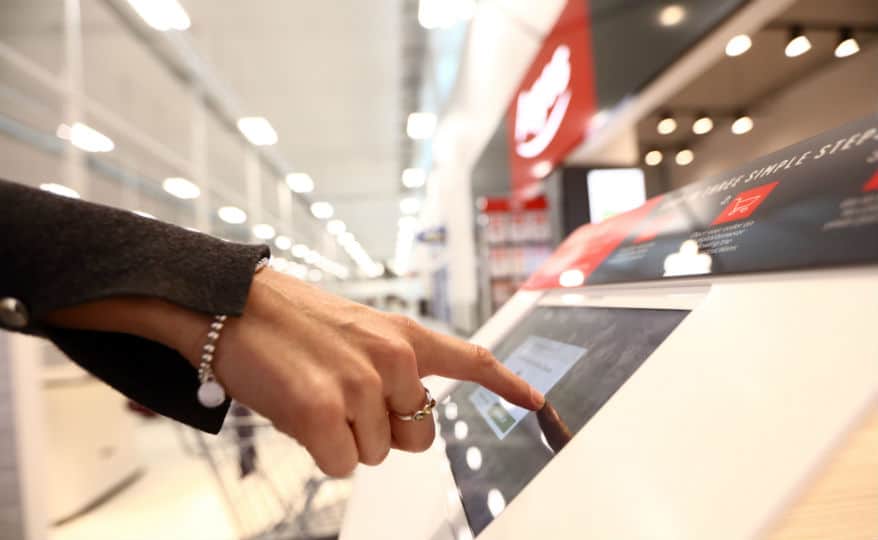
Argos launched its first self-service store in 2019, and now, many of its outlets in Sainsbury stores are self-service. Argos recently added visual search to its iOS app, allowing customers to search for products with a photo. In 2019, the store also launched Voice Shop, which enabled customers to use voice searches to shop the catalog through the Google Assistant platform. It was one of the first retailers in the United Kingdom that had this feature, adding another layer of shopping convenience to its customers.
Analyzing Argos eCommerce website
Argos has consistently been recognized for its multichannel shopping experience and is one of the most highly evaluated brands in eCommerce. We have analyzed the four-page templates of its site to identify eCommerce best practices and mistakes you should avoid.
A. Analyzing Argos’ homepage
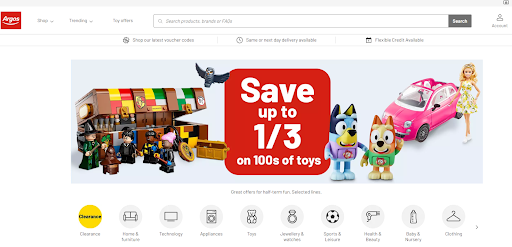
Argos’ home page has undergone many changes over its existence and now offers a cleaner look that is easy to read. It’s even undergoing a makeover in 2023.
What we liked
- Categories are easy to find and prominently displayed on the site.
- Banner ads on the homepage target audience using geolocation and past shopping history.
- Offers are prominently featured above the fold.
- It’s easy to search for an item.
- The page is mobile responsive and easy to navigate.
What we didn’t
- Some of the offers on the homepage were irrelevant.
- The sheer selection can be overwhelming: Since it started out as a catalog, there are plenty of categories and ads to peruse.
B. Analyzing Argos’ category page
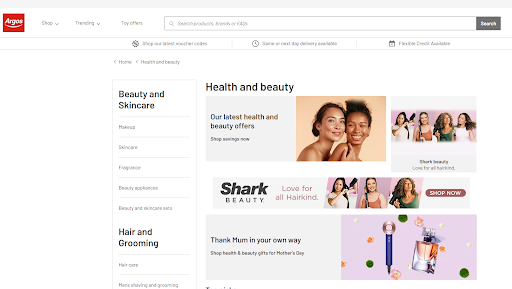
Argos category pages are the online equivalent of walking through a big box store.
What we liked
- Categories are easy to locate.
- On the mobile app, each category page features multiple subcategories to help filter product results.
- The site cuts off before it gets too long, making it less overwhelming.
- The sticky cart function helps users track products they may want to buy.
What we didn’t
- Other item statistics pop up when shopping to create a sense of urgency, a function that distracts the user from the browsing experience.
- Subcategories aren’t visible on the homepage.
C. Analyzing Argos’ product page
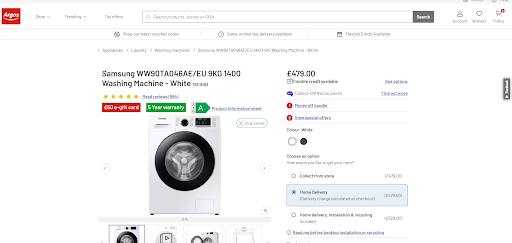
Since the original Argos marketing strategy is built around making products look attractive in a catalog, the retailer creates well-designed product pages.
What we liked
- Prices are prominently displayed under each product, helping users find the best deals.
- Customers can add items to their carts without having to click on a product.
- Key product features are illustrated and easy to read.
- Customers can see estimated delivery times based on their location.
What we didn’t
- Each product page features an offer to apply for an Argos credit card, which is distracting.
- You have to scroll through a lot of information to access details and reviews.
D. Analyzing Argos’ checkout process
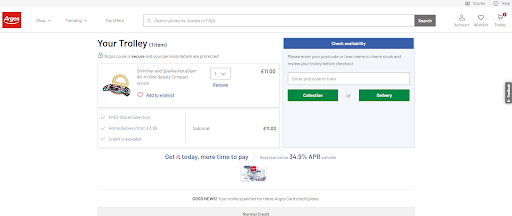
The checkout process is another way Argos makes shopping convenient for its customers.
What we liked:
- The trolley is easily accessible
- Stored payment information speeds up the checkout process
- It’s easy to track and manage existing orders
What we didn’t
- Some of the offers that are viewable on the website have already expired
- The touch screen doesn’t always work correctly
- The checkout page freezes on occasion
- You have to create an account to checkout
Challenges faced by Argos in implementing its omnichannel marketing strategy
Argos’ marketing strategy builds on convenience, so the brand needs to deliver on its promises. Like any retailer, the company has encountered challenges in implementing its strategy.
Logistical challenges
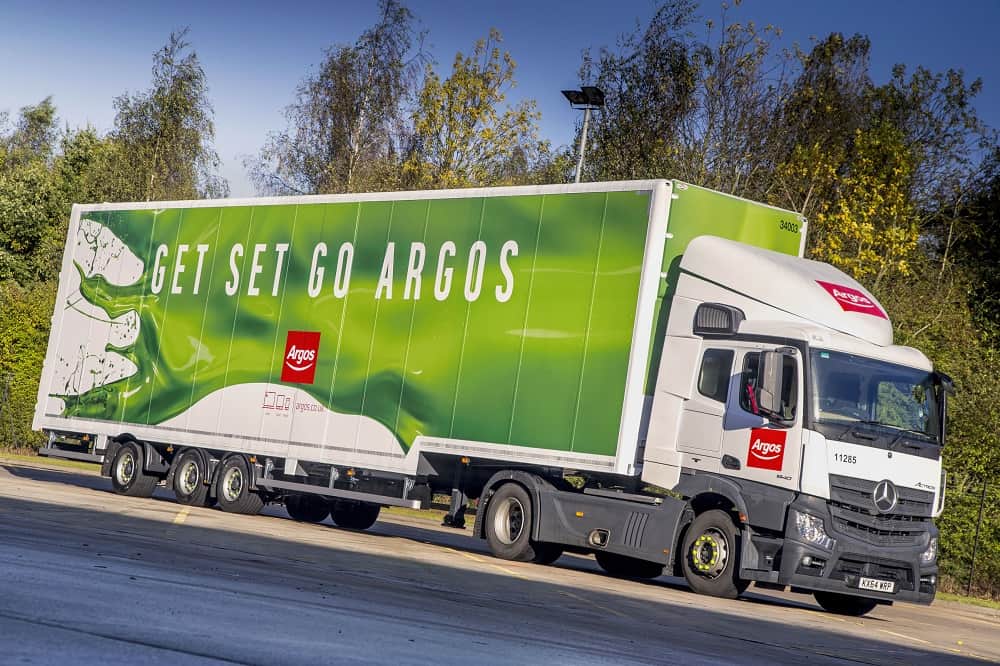
Logistics are one of the biggest hurdles faced by any eCommerce retailer. The Argos marketing mix revolves around customers being able to shop online and receive their products in a few days. Like many other retailers, Argos faced supply chain issues resulting from the COVID-19 pandemic.
The United Kingdom experienced worker shortages in 2021, impacting Argos’ ability to deliver consumer goods within its standard windows. Global supply chain issues also hit its electronics department.
How Argos overcame the challenge
Argos overcame its logistical challenges by improving its supply chain management strategy to enhance inventory management and anticipate peaks in demand.
Technological challenges
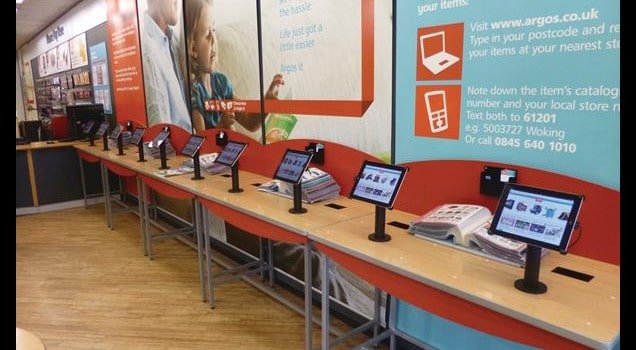
With a business based on a superior digital in-store experience, Argos relies on technology. Argos experienced some hiccups with its first digital stores: customers were not able to use the photo search function to shop and as a result, the self-checkout wasn’t easy. As Argos adds more technology to its locations, it should anticipate problems that require quick resolvent to keep customers coming back.
How Argos overcame the challenge
Argos has managed this challenge by adding 150 additional working positions in tech support and management.
Financial challenges
In its 50-year history, Argos has faced financial setbacks, most recently due to the COVID-19 pandemic and supply chain issues. The Argos marketing strategy emphasizes how fast customers can get merchandise, which has been disrupted through these supply chain issues.
An Argos financial analysis shows that the company has experienced a dip in revenue in the past few years. The UK is also facing inflation, leaving customers with less disposable income, leaving Argos with a drop in sales.
How Argos overcame the challenge
Argos’ parent company, Sainsbury, is dedicated to maintaining the Argos value proposition, delivering affordable products. It is also offering cost-saving programs to customers.
Human resources challenges
Argos is a large company employing thousands across the United Kingdom. The company strives to fill each position with the best employees from all over the country. However, this can be demanding in a company that large. In 2014, staff members at the company’s distribution centers chose to strike over their lack of work-life balance.
The company has recently come under fire for its changes stemming from the transition to new ownership. Workers who didn’t want to accept their new contract terms were told they might lose their jobs. Additionally, the company announced that it is about to close all stores in Ireland as of June 2023, which will remove over 500 jobs.
How Argos overcame the challenge
Argos is still managing its human resources challenges, recently agreeing to give pay raises to some of its workers. The company has created a plan to save money and will pass it on to its workers.
Interesting technologies Argos currently utilizes

Using the Buildwith tool, we scanned the giant’s UK website and highlighted the most impressive technologies we spotted.
Adobe Marketing Cloud
The Adobe Marketing Cloud offers engagement tools that other companies can use to manage, personalize, and optimize cross-channel campaigns. This tool likely allows Argos to use customer data to personalize their ads based on location and shopping history. It also gives the company access to analytics for better personalization and optimized campaigns.
New Relic
With New Relic, companies can monitor their application health and user experience in real time. With this tool, Argos can see how people use its app and take action if it experiences technical issues.
New Relic tells customers why their site is down, whether it’s a problem with the network or the server. Argos can, thus, maintain its customers’ ability to buy what they want when they want it. This ability helps with Argos’ customer satisfaction analysis.
ForeSee results
Since Argos’ marketing strategy involves keeping customers happy, the company needs to monitor customer experiences on its website. ForeSee uses artificial intelligence to analyze the user experience and create predictive models on whether customers will purchase, recommend, or return items and more.
With this tool, Argos can benchmark its performance and keep improving its website to improve the customer journey.
New technologies that could improve Argos’ customer engagement strategy
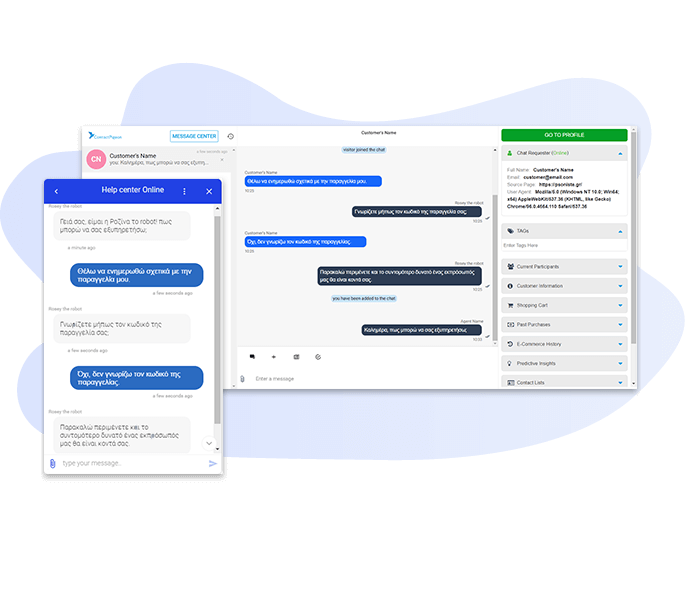
Argos could benefit from ContactPigeon’s Samaritan’s omnichannel chat. Argos could use the tool’s artificial intelligence and machine learning features to program messages that match its branding and style. By using Samaritan, Argos could simplify workflows by automating messages for routine customer actions. Its clients would also have 24/7 access to customer service without Argos having to spend more money on staffing.
Impressive Argos stats you should know
Even with all of its challenges in the past few years, Argos has maintained some impressive stats:
- Argos’ market share is robust. The store made up 59% of all digital sales in the United Kingdom in 2018 (Statista)
- Over half of UK furniture shoppers like Argos (Statista)
- About 40% of online furniture shoppers are likely to use Argos (Statista)
- Argos had 49.336 million visits in January 2023 (Sem Rush)
- Argos led sales of sporting goods and outdoor products in the UK in 2020, beating retailers like Sports Direct and Nike (Computer Weekly)
- Argos customers read 35% of all emails sent by the company in 2016, which is high for the retail industry. (Internet Retailing)
- Argos’ top categories in 2021 were toys, hobbies, and DIY (eCommerce DB)
Latest news about the UK retailer
With such high brand awareness, the Argos marketing strategy seems to be effective. Even a brand that has established itself as a household name should be committed to maintaining its branding. Part of that involves making the news. Here are some of the most recent news stories about Argos.
Argos is closing all stores in Ireland
Since its inception, Argos has not picked up the same level of steam in Ireland. One reason is that the company isn’t closed on Sundays, which is ordinary for Irish businesses. However, the primary reason for closing businesses in Ireland is that the investment needed to modernize or the stores wouldn’t be viable. Argos is still keeping stores open in Northern Ireland, which is part of the UK. Its remaining 34 Irish locations will close by June 2023.
Bestway took a 3.45% stake in Sainsbury
The privately held group Bestway took a 3.45% stake in Sainsbury, which owns Argos. This move allowed the company’s stock price to rise, which put management in a better position to enact the Argos marketing strategy.
Argos customers are going wild over a fan heater
As winter brings cold snaps to parts of the UK, Argos sells multiple small fan heaters. These heaters, which cost £40 are effective at keeping customers warm and satisfied. They can heat a room in minutes, making them great for UK families pinching pennies in the wake of inflation.
Discover more resources about FMCG retailers
- Walmart Marketing Strategy: Decoding the Success of the US Multinational Retailer
- ALDI’s marketing strategy: The key growth ingredients of the FMCG titan
- Sainsbury’s Marketing Strategy: Becoming the Second-Largest Supermarket Chain in the UK
- Tesco Case Study: How an Online Grocery Goliath Was Born
- Analyzing Lidl’s Marketing Strategy: How the Discount Supermarket Leader Scaled
- The Marks and Spencer eCommerce Case Study: 3 Growth Lessons for Retailers
- The Ocado marketing strategy: How it reached the UK TOP50 retailers list
- ASDA’s marketing strategy: How the British supermarket chain reached the top
- FMCG Marketing Strategies to Increase YOY Revenue
What we’ve learned from Argos’ marketing strategy
Argos has been in business for over half a century, partly by recognizing what customers want and shifting with the trends. Argos’ retail innovation strategy has been to test new trends and roll them out when they’re successful, like:
- The company opened locations to supplement its catalog business.
- It was an early adopter of in-store technology, replacing bulky catalogs with iPads that gave customers access to an endless database of products.
- The Argos online marketing strategy involves personalizing ads and targeting the right customers based on their location and preferences.
Unlike some Argos competitors, the store has managed to stay afloat during COVID-19 and is poised to come back stronger. This is no time for idling and resting. To replicate this strategy, research the right customer engagement platform for your business needs and book a free customer engagement consultation with ContactPigeon.
Spending time on Linkedin? Follow us and get notified of our thought-leadership content:

Let’s Help You Scale Up



